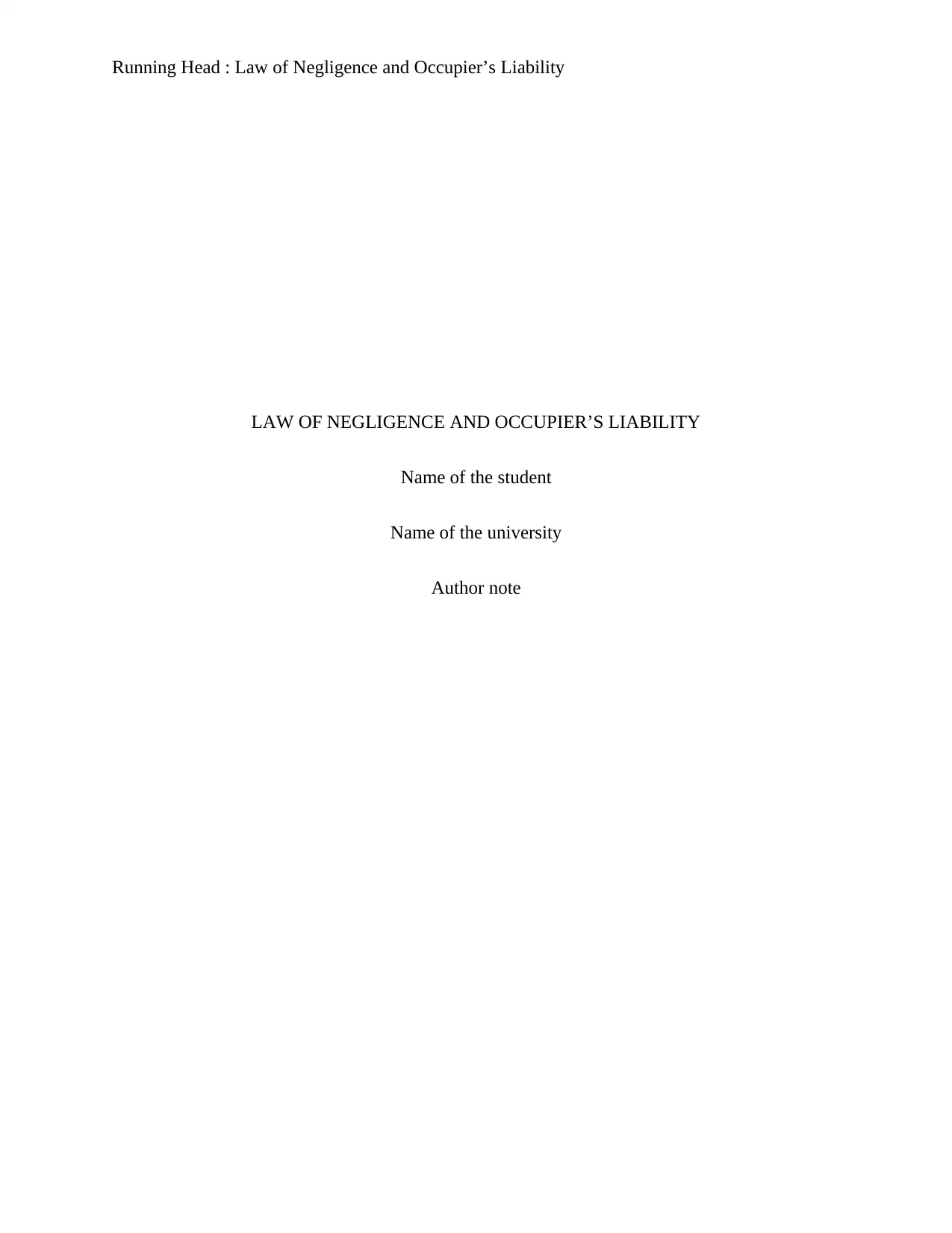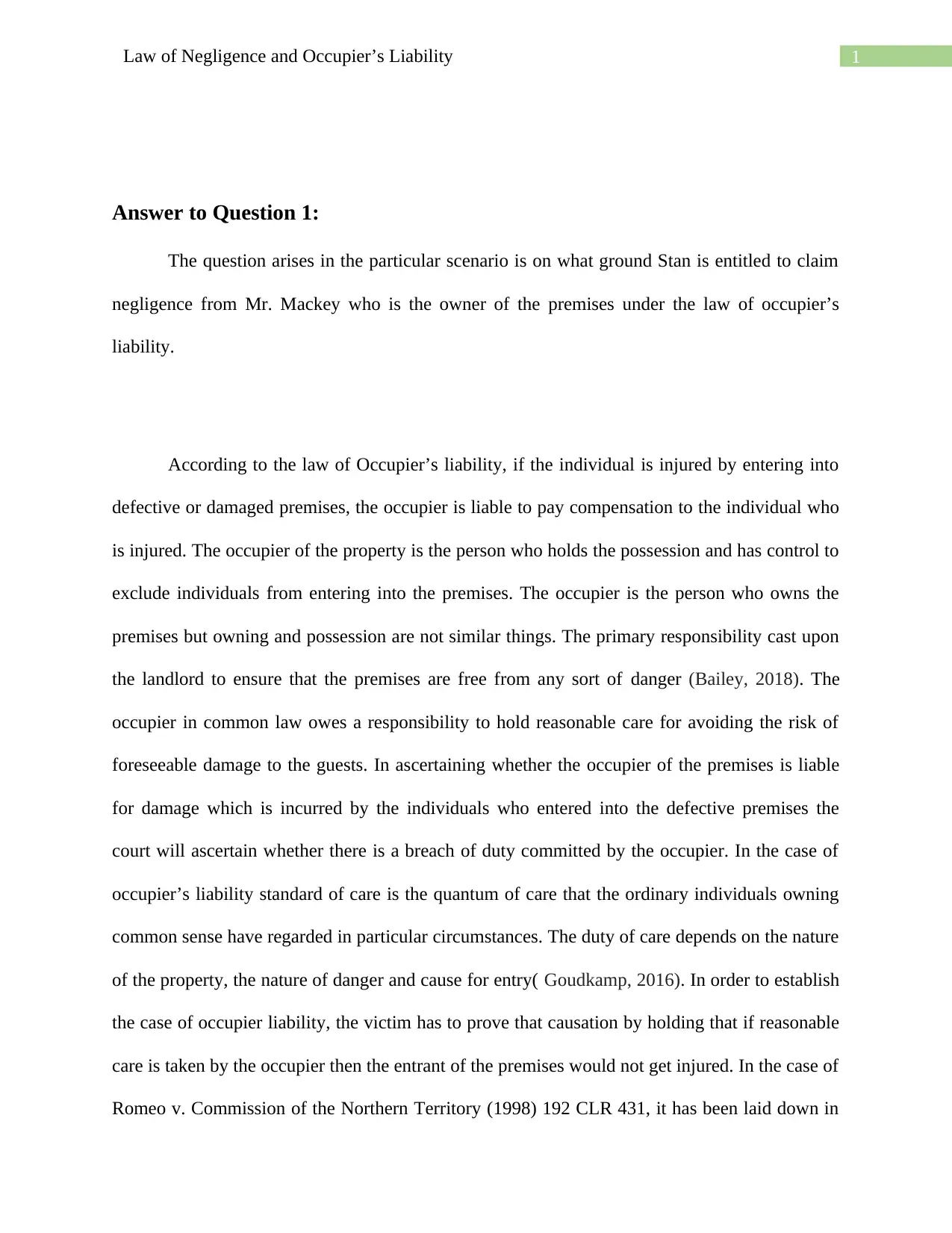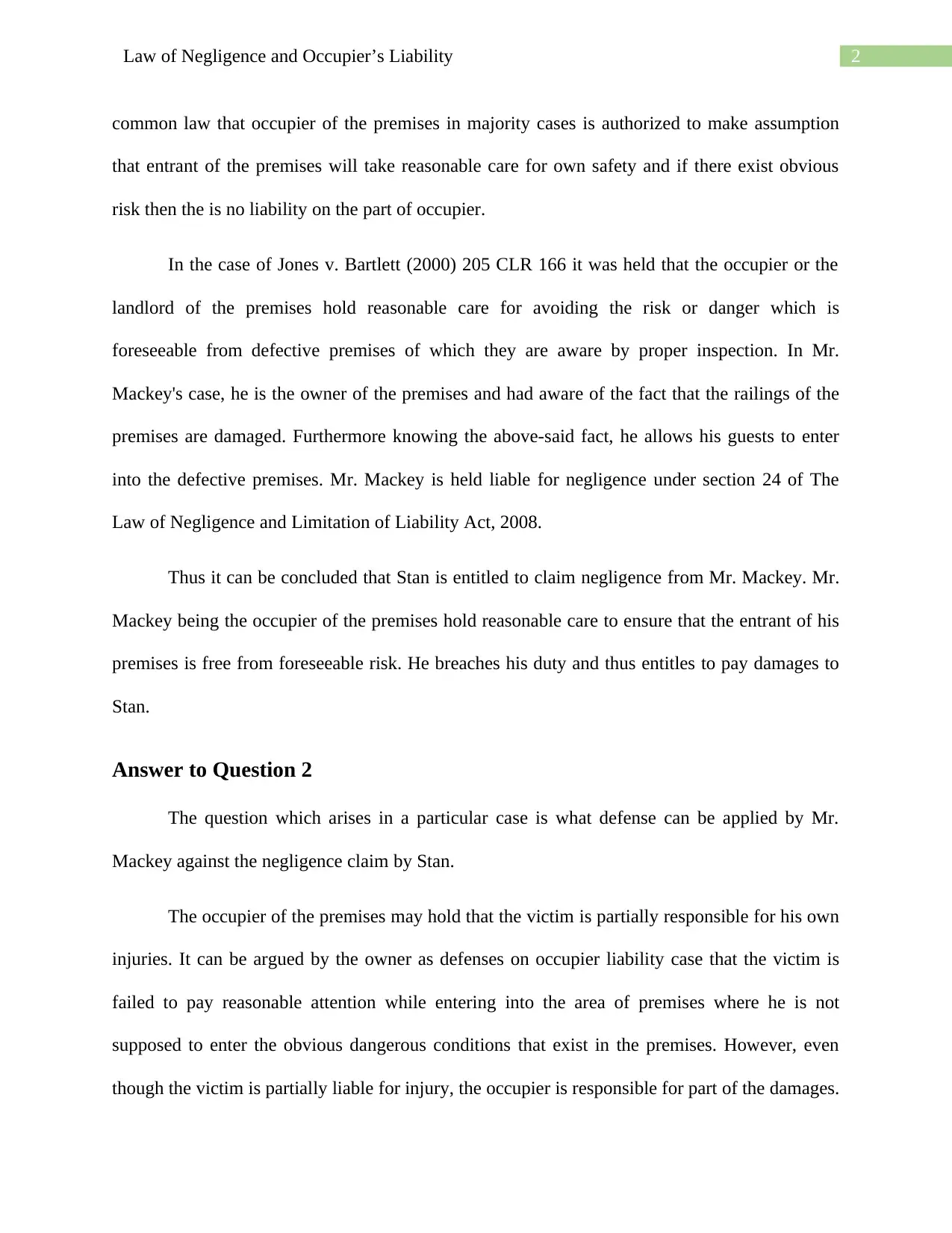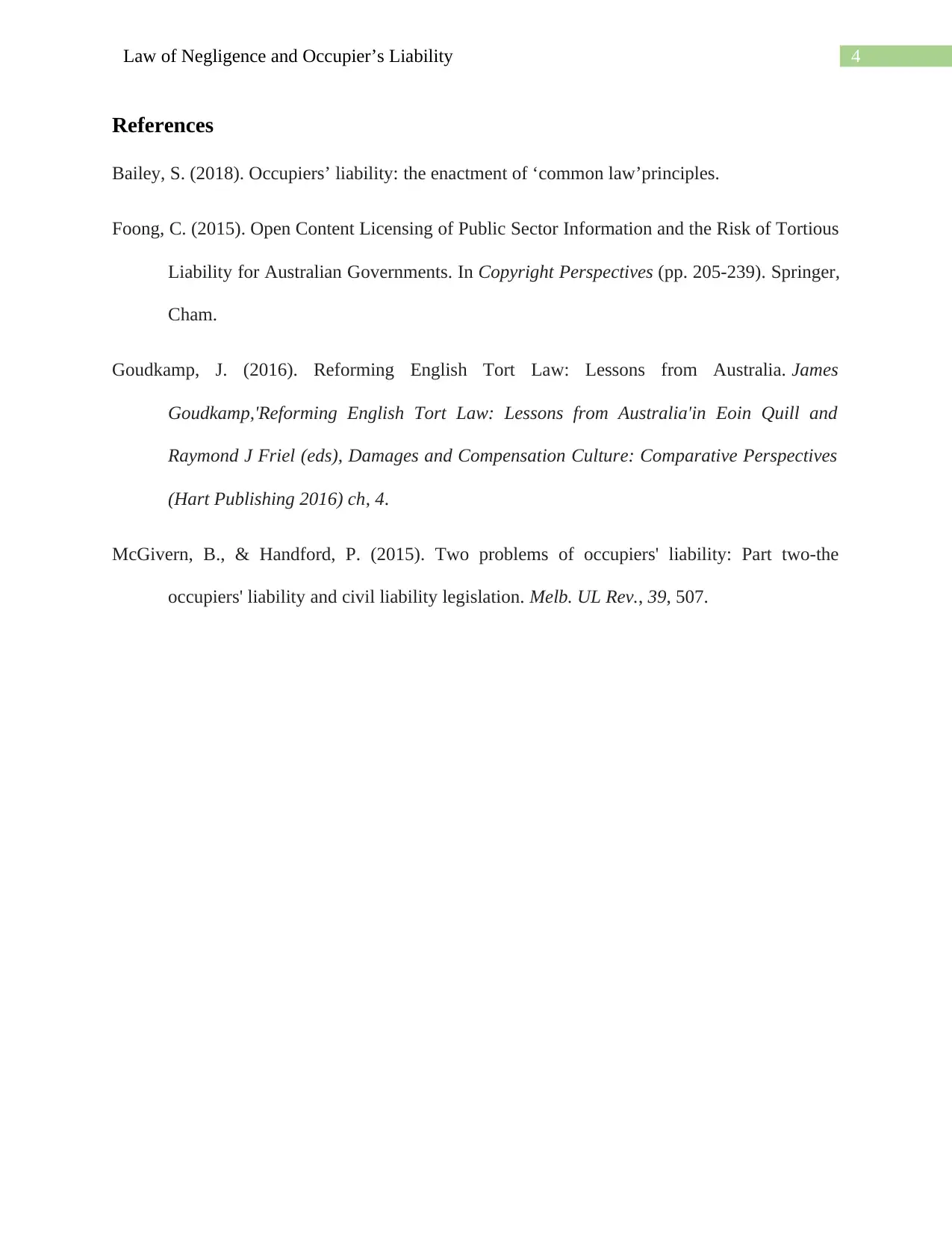Fundamentals of Law: Occupier's Liability and Negligence Essay
VerifiedAdded on 2022/08/17
|5
|1098
|22
Essay
AI Summary
This essay analyzes a case scenario involving the law of negligence and occupier's liability. It addresses the question of whether an owner, Mr. Mackey, is liable for negligence when a guest, Stan, is injured on his property due to damaged railings. The essay explores the legal principles of occupier's liability, emphasizing the duty of care owed by the occupier to ensure the premises are safe for entrants. It examines relevant case law, including Romeo v. Commission of the Northern Territory and Jones v. Bartlett, to establish the standard of care and the occupier's responsibility. Furthermore, the essay discusses potential defenses Mr. Mackey could raise against Stan's negligence claim, such as contributory negligence and volenti non fit injuria. The analysis considers whether Mr. Mackey took reasonable precautionary measures and whether Stan was aware of the danger. The essay concludes with a determination of Mr. Mackey's liability based on the application of the law to the facts presented.

Running Head : Law of Negligence and Occupier’s Liability
LAW OF NEGLIGENCE AND OCCUPIER’S LIABILITY
Name of the student
Name of the university
Author note
LAW OF NEGLIGENCE AND OCCUPIER’S LIABILITY
Name of the student
Name of the university
Author note
Paraphrase This Document
Need a fresh take? Get an instant paraphrase of this document with our AI Paraphraser

1Law of Negligence and Occupier’s Liability
Answer to Question 1:
The question arises in the particular scenario is on what ground Stan is entitled to claim
negligence from Mr. Mackey who is the owner of the premises under the law of occupier’s
liability.
According to the law of Occupier’s liability, if the individual is injured by entering into
defective or damaged premises, the occupier is liable to pay compensation to the individual who
is injured. The occupier of the property is the person who holds the possession and has control to
exclude individuals from entering into the premises. The occupier is the person who owns the
premises but owning and possession are not similar things. The primary responsibility cast upon
the landlord to ensure that the premises are free from any sort of danger (Bailey, 2018). The
occupier in common law owes a responsibility to hold reasonable care for avoiding the risk of
foreseeable damage to the guests. In ascertaining whether the occupier of the premises is liable
for damage which is incurred by the individuals who entered into the defective premises the
court will ascertain whether there is a breach of duty committed by the occupier. In the case of
occupier’s liability standard of care is the quantum of care that the ordinary individuals owning
common sense have regarded in particular circumstances. The duty of care depends on the nature
of the property, the nature of danger and cause for entry( Goudkamp, 2016). In order to establish
the case of occupier liability, the victim has to prove that causation by holding that if reasonable
care is taken by the occupier then the entrant of the premises would not get injured. In the case of
Romeo v. Commission of the Northern Territory (1998) 192 CLR 431, it has been laid down in
Answer to Question 1:
The question arises in the particular scenario is on what ground Stan is entitled to claim
negligence from Mr. Mackey who is the owner of the premises under the law of occupier’s
liability.
According to the law of Occupier’s liability, if the individual is injured by entering into
defective or damaged premises, the occupier is liable to pay compensation to the individual who
is injured. The occupier of the property is the person who holds the possession and has control to
exclude individuals from entering into the premises. The occupier is the person who owns the
premises but owning and possession are not similar things. The primary responsibility cast upon
the landlord to ensure that the premises are free from any sort of danger (Bailey, 2018). The
occupier in common law owes a responsibility to hold reasonable care for avoiding the risk of
foreseeable damage to the guests. In ascertaining whether the occupier of the premises is liable
for damage which is incurred by the individuals who entered into the defective premises the
court will ascertain whether there is a breach of duty committed by the occupier. In the case of
occupier’s liability standard of care is the quantum of care that the ordinary individuals owning
common sense have regarded in particular circumstances. The duty of care depends on the nature
of the property, the nature of danger and cause for entry( Goudkamp, 2016). In order to establish
the case of occupier liability, the victim has to prove that causation by holding that if reasonable
care is taken by the occupier then the entrant of the premises would not get injured. In the case of
Romeo v. Commission of the Northern Territory (1998) 192 CLR 431, it has been laid down in

2Law of Negligence and Occupier’s Liability
common law that occupier of the premises in majority cases is authorized to make assumption
that entrant of the premises will take reasonable care for own safety and if there exist obvious
risk then the is no liability on the part of occupier.
In the case of Jones v. Bartlett (2000) 205 CLR 166 it was held that the occupier or the
landlord of the premises hold reasonable care for avoiding the risk or danger which is
foreseeable from defective premises of which they are aware by proper inspection. In Mr.
Mackey's case, he is the owner of the premises and had aware of the fact that the railings of the
premises are damaged. Furthermore knowing the above-said fact, he allows his guests to enter
into the defective premises. Mr. Mackey is held liable for negligence under section 24 of The
Law of Negligence and Limitation of Liability Act, 2008.
Thus it can be concluded that Stan is entitled to claim negligence from Mr. Mackey. Mr.
Mackey being the occupier of the premises hold reasonable care to ensure that the entrant of his
premises is free from foreseeable risk. He breaches his duty and thus entitles to pay damages to
Stan.
Answer to Question 2
The question which arises in a particular case is what defense can be applied by Mr.
Mackey against the negligence claim by Stan.
The occupier of the premises may hold that the victim is partially responsible for his own
injuries. It can be argued by the owner as defenses on occupier liability case that the victim is
failed to pay reasonable attention while entering into the area of premises where he is not
supposed to enter the obvious dangerous conditions that exist in the premises. However, even
though the victim is partially liable for injury, the occupier is responsible for part of the damages.
common law that occupier of the premises in majority cases is authorized to make assumption
that entrant of the premises will take reasonable care for own safety and if there exist obvious
risk then the is no liability on the part of occupier.
In the case of Jones v. Bartlett (2000) 205 CLR 166 it was held that the occupier or the
landlord of the premises hold reasonable care for avoiding the risk or danger which is
foreseeable from defective premises of which they are aware by proper inspection. In Mr.
Mackey's case, he is the owner of the premises and had aware of the fact that the railings of the
premises are damaged. Furthermore knowing the above-said fact, he allows his guests to enter
into the defective premises. Mr. Mackey is held liable for negligence under section 24 of The
Law of Negligence and Limitation of Liability Act, 2008.
Thus it can be concluded that Stan is entitled to claim negligence from Mr. Mackey. Mr.
Mackey being the occupier of the premises hold reasonable care to ensure that the entrant of his
premises is free from foreseeable risk. He breaches his duty and thus entitles to pay damages to
Stan.
Answer to Question 2
The question which arises in a particular case is what defense can be applied by Mr.
Mackey against the negligence claim by Stan.
The occupier of the premises may hold that the victim is partially responsible for his own
injuries. It can be argued by the owner as defenses on occupier liability case that the victim is
failed to pay reasonable attention while entering into the area of premises where he is not
supposed to enter the obvious dangerous conditions that exist in the premises. However, even
though the victim is partially liable for injury, the occupier is responsible for part of the damages.
⊘ This is a preview!⊘
Do you want full access?
Subscribe today to unlock all pages.

Trusted by 1+ million students worldwide

3Law of Negligence and Occupier’s Liability
There is another common defense that can hold by the occupier is that in order to establish
defense is that the owner may show that the victim has knowledge of danger. Nevertheless, he
exposed himself voluntarily to the risk (McGivern & Handford, 2015). The occupier can raise
contributory negligence as defenses by which the plaintiff voluntarily participate to their own
risk or injury which prevents the occupier from awarding damages. According to section 14 of
Law of Negligence and Limitation of Liability Act, 2008 the defense of volunti non fit injuria
can be raised by which the person who incurred harm is aware of the danger unless the victim
proved that balance of possibilities that individuals have no knowledge of the risk.
Mr. Mackey who is the occupier of the premises, can raise the defense that he had taken
reasonable precautionary measures by putting caution on the damaged property. Stan is the guest
of his premises who is aware of the fact that the premises are dangerous but take the risk
voluntarily (Foong, 2015). Nevertheless, it is held from the above-mentioned fact that Mr.
Mackey is not liable to pay damage on the ground of volenti non fit injuria.
Thus it can be concluded that Mr. Mackey is not liable to pay damages as he is not
negligent and take reasonable care towards the entrants of the property.
There is another common defense that can hold by the occupier is that in order to establish
defense is that the owner may show that the victim has knowledge of danger. Nevertheless, he
exposed himself voluntarily to the risk (McGivern & Handford, 2015). The occupier can raise
contributory negligence as defenses by which the plaintiff voluntarily participate to their own
risk or injury which prevents the occupier from awarding damages. According to section 14 of
Law of Negligence and Limitation of Liability Act, 2008 the defense of volunti non fit injuria
can be raised by which the person who incurred harm is aware of the danger unless the victim
proved that balance of possibilities that individuals have no knowledge of the risk.
Mr. Mackey who is the occupier of the premises, can raise the defense that he had taken
reasonable precautionary measures by putting caution on the damaged property. Stan is the guest
of his premises who is aware of the fact that the premises are dangerous but take the risk
voluntarily (Foong, 2015). Nevertheless, it is held from the above-mentioned fact that Mr.
Mackey is not liable to pay damage on the ground of volenti non fit injuria.
Thus it can be concluded that Mr. Mackey is not liable to pay damages as he is not
negligent and take reasonable care towards the entrants of the property.
Paraphrase This Document
Need a fresh take? Get an instant paraphrase of this document with our AI Paraphraser

4Law of Negligence and Occupier’s Liability
References
Bailey, S. (2018). Occupiers’ liability: the enactment of ‘common law’principles.
Foong, C. (2015). Open Content Licensing of Public Sector Information and the Risk of Tortious
Liability for Australian Governments. In Copyright Perspectives (pp. 205-239). Springer,
Cham.
Goudkamp, J. (2016). Reforming English Tort Law: Lessons from Australia. James
Goudkamp,'Reforming English Tort Law: Lessons from Australia'in Eoin Quill and
Raymond J Friel (eds), Damages and Compensation Culture: Comparative Perspectives
(Hart Publishing 2016) ch, 4.
McGivern, B., & Handford, P. (2015). Two problems of occupiers' liability: Part two-the
occupiers' liability and civil liability legislation. Melb. UL Rev., 39, 507.
References
Bailey, S. (2018). Occupiers’ liability: the enactment of ‘common law’principles.
Foong, C. (2015). Open Content Licensing of Public Sector Information and the Risk of Tortious
Liability for Australian Governments. In Copyright Perspectives (pp. 205-239). Springer,
Cham.
Goudkamp, J. (2016). Reforming English Tort Law: Lessons from Australia. James
Goudkamp,'Reforming English Tort Law: Lessons from Australia'in Eoin Quill and
Raymond J Friel (eds), Damages and Compensation Culture: Comparative Perspectives
(Hart Publishing 2016) ch, 4.
McGivern, B., & Handford, P. (2015). Two problems of occupiers' liability: Part two-the
occupiers' liability and civil liability legislation. Melb. UL Rev., 39, 507.
1 out of 5
Related Documents
Your All-in-One AI-Powered Toolkit for Academic Success.
+13062052269
info@desklib.com
Available 24*7 on WhatsApp / Email
![[object Object]](/_next/static/media/star-bottom.7253800d.svg)
Unlock your academic potential
Copyright © 2020–2025 A2Z Services. All Rights Reserved. Developed and managed by ZUCOL.





